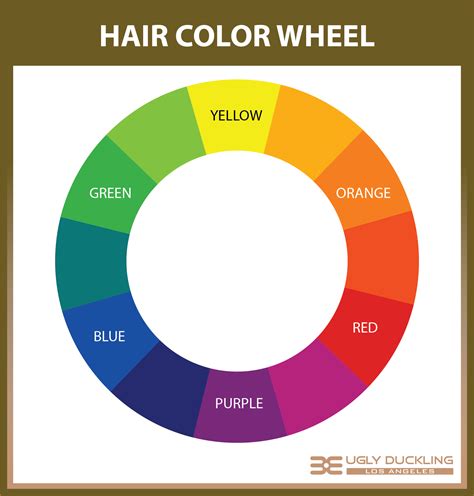The hair color wheel is an invaluable tool for hairstylists and anyone looking to achieve the perfect hair color. Understanding how the color wheel works can help you make informed decisions about your hair color, whether you’re a professional or a home stylist.

Understanding the Hair Color Wheel
The hair color wheel consists of 12 main colors:
- Warm colors: Red, orange, and yellow
- Cool colors: Blue, green, and purple
- Neutral colors: Black, brown, and white
These colors are arranged in a circular pattern, with complementary colors (colors opposite each other on the wheel) directly across from each other. For example, red and green are complementary colors, as are blue and orange.
Why the Hair Color Wheel Matters
The hair color wheel matters because it helps you understand how different colors affect each other when mixed or placed next to each other. This knowledge can help you:
- Understand undertones: All hair colors have undertones, which are the underlying shades that influence the overall color. Understanding the undertones of your hair can help you choose colors that complement them and avoid unflattering results.
- Neutralize unwanted tones: If you have unwanted tones in your hair, such as orange or brassy tones, you can use the color wheel to identify complementary colors that will neutralize those tones.
- Create a harmonious look: By carefully choosing colors from the color wheel, you can create hair looks that are visually appealing and complement your features.
Benefits of Using the Hair Color Wheel
Using the hair color wheel offers several benefits:
- Achieve accurate color matching: The color wheel helps you visualize how different colors will interact with each other, ensuring that you achieve the desired color.
- Avoid color disasters: By understanding the relationships between colors, you can avoid making costly and unflattering color mistakes.
- Experiment with new colors: The color wheel encourages experimentation and helps you explore new color possibilities.
- Improve communication with your hairstylist: By understanding the color wheel, you can effectively communicate your color preferences to your hairstylist, resulting in a more satisfying outcome.
Common Mistakes to Avoid
When using the hair color wheel, avoid these common mistakes:
- Ignoring undertones: Undertones play a crucial role in the final hair color. Failing to consider undertones can lead to unflattering results.
- Mixing too many colors: Using too many colors can result in a muddy or undefined result. Stick to a few complementary colors for optimal results.
- Overlapping colors: Overlapping colors can create unwanted tones or muddy the overall color. Apply colors carefully and avoid overlapping them unless intentionally using a technique like blending.
- Ignoring skin tone: Your skin tone can significantly influence which hair colors look best on you. Consider your skin tone when choosing colors from the color wheel.
4 Tables for Hair Color
Table 1: Complimentary Color Pairs
| Warm Color | Complementary Cool Color |
|---|---|
| Red | Green |
| Orange | Blue |
| Yellow | Purple |
Table 2: Color Undertones
| Hair Color | Undertones |
|---|---|
| Black | Blue, green |
| Brown | Red, orange |
| Blonde | Yellow, orange |
| Red | Orange, yellow |
| Orange | Yellow, red |
| Yellow | Red, orange |
Table 3: Color Neutralization
| Unwanted Tone | Neutralizing Color |
|---|---|
| Orange | Blue |
| Brassy | Violet |
| Red | Green |
| Green | Red |
| Purple | Yellow |
Table 4: Hair Color for Different Skin Tones
| Skin Tone | Flattering Hair Colors | Colors to Avoid |
|---|---|---|
| Fair Skin | Ashy blondes, light browns, auburn | Warm blondes, copper |
| Warm Skin | Warm blondes, golden browns, reds | Ashy blondes, cool blacks |
| Olive Skin | Dark browns, reds, warm blondes | Platinum blondes, ash blacks |
| Dark Skin | Deep blacks, rich browns, vibrant reds | Light blondes, pastels |
FAQs
1. What is the most flattering hair color?
The most flattering hair color depends on your skin tone and personal preferences. However, some universally flattering colors include warm blondes, golden browns, and rich reds.
2. Can I use the hair color wheel to correct color mistakes?
Yes. By understanding color relationships, you can identify the complementary color that will neutralize unwanted tones.
3. I want to experiment with new hair colors but I’m afraid of making a mistake. What should I do?
Consider using temporary hair color or consulting with a professional hairstylist who can help you choose a flattering color and minimize the risk of mistakes.
4. How can I use the hair color wheel to create a unique color combination?
There are many ways to use the color wheel to create unique color combinations. One approach is to choose two complementary colors and then add a neutral shade to balance the look.
5. What is the best source for information about the hair color wheel?
Reputable sources for information about the hair color wheel include books, articles, and websites written by professionals in the hair industry.
6. How can I maintain the vibrancy of my hair color?
To maintain the vibrancy of your hair color, use color-protecting shampoos and conditioners, avoid excessive heat styling, and schedule regular touch-ups with your hairstylist.
7. What are some creative ways to use the color wheel in hair styling?
Creative ways to use the color wheel in hair styling include creating color melts, using balayage techniques, and experimenting with contrasting colors for a bold look.
8. What is a color bomb?
A color bomb is a highly pigmented, temporary hair color that is applied directly to the hair without the use of peroxide or ammonia. It’s a great way to explore new colors without making a long-term commitment.
